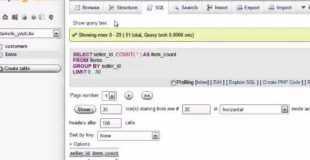Facebook – https://www.facebook.com/TheNewBoston-464114846956315/ GitHub – https://github.com/buckyroberts Google+ …
Original source
MySQL Database Tutorial – 19 – GROUP BY


Facebook – https://www.facebook.com/TheNewBoston-464114846956315/ GitHub – https://github.com/buckyroberts Google+ …
Original source
34 responses to “MySQL Database Tutorial – 19 – GROUP BY”
Why did you feel the need to mention/tell us that you had phlegm in your throat? You are a low life, disgusting piece of dog shit! You should do the world a favor and go jump off of a fucking bridge head first, you dirt bag! You're one sorry motherfucker, you worthless sack of shit!
can you save all these requests in myphpadmin or are they all 1 off requests?
DFDFDF
Thanks Bucky I have learned PHP and MySQL from your videos. I am planning for a job if i get one. Then we will have a party together.
very well explained …..also write questions (English Statements)of queries as well,that will make easier to understand …!
hahahaha <====3
the seller id number 1 has a used diaper from his sister lool
When you build an actual website using PHP or smh,
you can add all this SQL queries built-in as GUIs somewhere
like on the left side of your online store, social site (whatever).
Why do we learn it?
This query work good (SELECT EmployeeName, COUNT( * ) AS item_count
FROM coder
GROUP BY EmployeeName) in sql section and this is showed me require result in sql but when i implement it that it is show me just one name that is good but that time the number of record of same name appear just once and other record is not appear. now i want to know how i can saw other result which it is showed me in sql and not fetched in website please.
sir in short words one user A have a ten records in ten rows and when i will fetch it dynamically i want to show just name of user A and ten record under to this when user A upload new data this will come to under the name of A and same like other user two
Hi thenewboston sir please help me this is my problem i have a two section of my website number#1 where one user name A register and fill form and upload data to my website and in section two the other user can view of uploaded data by User A and next user become register to my website and upload data in section one and other user can view this data too in section two. In section two all data fetched dynamically form database. After few days user A login and upload another data on website in section one.Now what i want to show in section two if user name will be same the data will go to the under of name A if user is different then data goes to another row.i develop system but problem is every time the new row append with same name in section two. please any one can give me some good suggestions thanks
Does it remind him of the Swedish Chef from the Muppets? That's what I see.
good explaining , nice style, much like !
Thank you very much!! You saved my live!
Couldn't figure out group by in my book, but this did the trick, thx!
lol >=3
Tilt 90' HE is actually thinking about a lady body
how to break the one long statement of mysql into multiple lines…….???
please thenewboston sir give me the answer..
fucking easiest tutorial. thanks!!!
pretty damn sweet haan?
>=3 evil kitty face
I love ur tutorials. They help a lot. I have a question regarding grouping, count and such. Do u have an email address I could write u to? Thx
Couldn't you do "HAVING item_count >=3" instead?
You are my hero Bucky !!
this tut solved my query!! xD
Can anyone tell me the difference between group by and Distinct?
Order by calculated item_count desc
Having calculated item_count=3
If you would follow series from beginning you would already know that for long time 🙂
Notice that LIMIT was added after the query!
pretty damn sweet han
It's because you're using 'seller_id' in the GROUP BY clause (or the WHERE if you're just doing it for just one seller) so the stuff it is counting is how many times the user appears, which is equal to how many items the user is selling.
— Try removing the COUNT clause to see what happens without it:
SELECT seller_id FROM items WHERE seller_id=1;
— Then add COUNT back in to see what exactly it is doing.
SELECT seller_id, COUNT(*) AS item_count FROM items WHERE seller_id=1;
Hope that helps.
this is getting more and more fun
and more complicated, love it, thanks Bucky
Well if you noticed Bucky does FROM items not FROM customers.